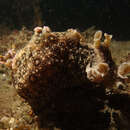en
names in breadcrumbs


This species is fairly abundant and not believed to need any special conservation efforts.
US Federal List: no special status
CITES: no special status
The eggs of Aplysia dactylomela are frequently seen in grass beds, intertidal to approximately three meters deep; they appear as a long tangled string of variably shaded green or brown. The large number of eggs produced requires that there be little yolk, early development to the veliger stage, and a long, one month stay in the plankton. Following this veliger stage, the larvae settle on algae where they grow and metamorphose. They continue to feed and grow to sexual maturity. The red algae, Laurencia has been shown to trigger veliger metamorphosis. All of the above were conducted under laboratory conditions.
Development - Life Cycle: metamorphosis
Aplysia dactylomela has very large ganglion nerve cells, specifically of interest is the right giant neuron located in the abdominal ganglion. This neuron is very similar to those in vertebrates, making them good subjects for electrophysiological studies as well as conditioned responses. These neurons are valuable for neurological research, as long lasting changes in neuronal behavior can be detected on the level of a single cell as a result of repeated and concommitant pairing of two inputs.
Positive Impacts: research and education
This species is one of many that graze on algae in shallow warm water.
Aplysia dactylomela feeds on red and green algae. It uses its jaws to grasp the algae and its radula to pull the algae into its buccal cavity. The crop in A. dactylomela is lined with chitinous plates and acts like a gizzard to aide in the digestion of the larger seaweeds that it eats.
Foods eaten: Chondrococcus hornemanni, Ulva reticulata, Laurencia spp., Martensia fragilis and Spyridia filamentosa.
Plant Foods: algae
Primary Diet: herbivore (Algivore)
Aplysia dactylomela is found world wide in tropical to warm temperate waters.
Biogeographic Regions: indian ocean (Native ); atlantic ocean (Native ); pacific ocean (Native )
Aplysia dactylomela is commonly found in sea grass beds where it feeds.
Range depth: intertidal to 20 m.
Habitat Regions: tropical ; saltwater or marine
Other Habitat Features: intertidal or littoral
Following their peak spawn and maximum size A. dactylomela begins to lose weight and spawning declines, death soon follows.
Average lifespan
Status: captivity: 10 to 11 months.
Aplysia dactylomela is generally a pale yellow to green color, though this varies greatly with the food that they consume, as they may be more orange if their diet consists primarily of red algae. A characteristic that differentiates A. dactylomela from others in its genus is the irregular black rings that cover its body. The dorsal surface of the mantle and parapodia are marked with irregular black blotches forming incomplete rings, while the remainder of its body is marked with more complete rings. The foot is broad and well developed, its anterior end is rounded, and the posterior end is more bluntly pointed. The foot has a rough texture, in contrast to the smooth soft surface of the rest of its body. The parapodia are an extension of the foot, in A. dactylomela they are high and thin, allowing the animals to swim in the water column. A reduced shell is covered by the mantle and the gills are located on the right side of the mantle between the shell and the right parapodia.
Other Physical Features: ectothermic ; heterothermic ; bilateral symmetry
When feeling threatened A. dactylomela will elicit a quick downward movement of its parapodia over its back. It may also release foul fluids from both the opaline gland and the purple dye cavity.
The idea that A. dactylomela releases ink and opaline in defensive situations is widely held. Much of this ascription is based on electroneurophysiological studies. However, further studies were unable to confirm that inking was due to interaction with a predator.
Known Predators:
In laboratory conditions, Aplysia dactylomela has a single reproductive period characterized by repeated spawning. Their first spawn takes place when they are roughly two months old and continues every two to four days until the end of their reproductive cycle roughly seven months later. They continue to feed and grow until they reach a maximum size. At this time they have also reached their peak spawn production. Throughout their seven month reproductive period each adult can produce an estimated 67 million eggs.
Mating System: polygynandrous (promiscuous)
Like all species of Aplysia, A. dactylomela is hermaphroditic. The male genital opening lies just below the base of the right anterior tentacle, positioned between the right eye and the right side of the mouth. A strongly defined ciliated groove extends dorsally backward from male genetalia between the parapodia to the hermaphroditic orifice, which is marked by a dark depression. The groove is marked by a narrow black line stretching from the male genital opening to the hermaphroditic duct. When mating, one A. dactylomela, acting as a male will climb partially onto a second A. dactylomela, acting as a female, insert the male genetalia and releasing sperm into the hermaphroditic duct of the second. In this manner they form chains of up to 12 organisms, each acting as male and female simultaneously, the first in the chain acting only as a female, and the last acting only as a male.
Breeding season: 7 months
Average number of offspring: 67,000,000.
Average age at sexual or reproductive maturity (female): 2 months.
Average age at sexual or reproductive maturity (male): 2 months.
Key Reproductive Features: semelparous ; year-round breeding ; simultaneous hermaphrodite; sexual ; fertilization (Internal ); oviparous
These animals invest very little in each offspring. Individual eggs receive relatively little yolk, and there is no investment in offspring once the fertilized eggs are laid.
Parental Investment: pre-fertilization (Provisioning, Protecting: Female)